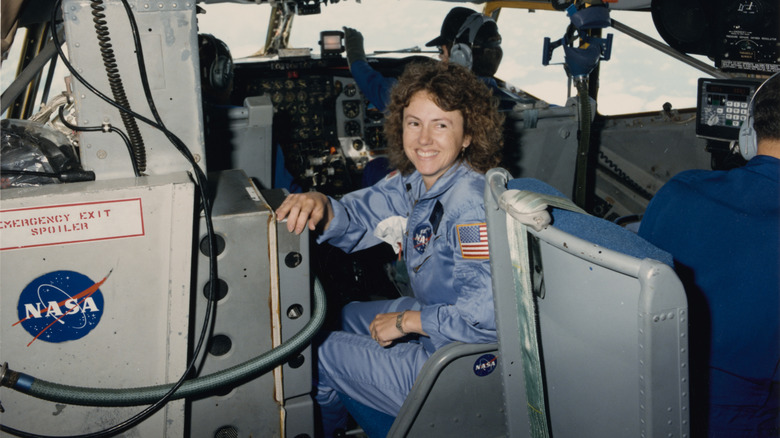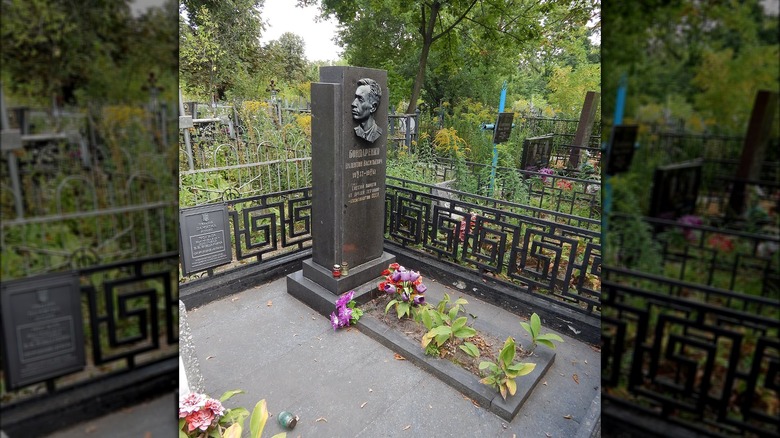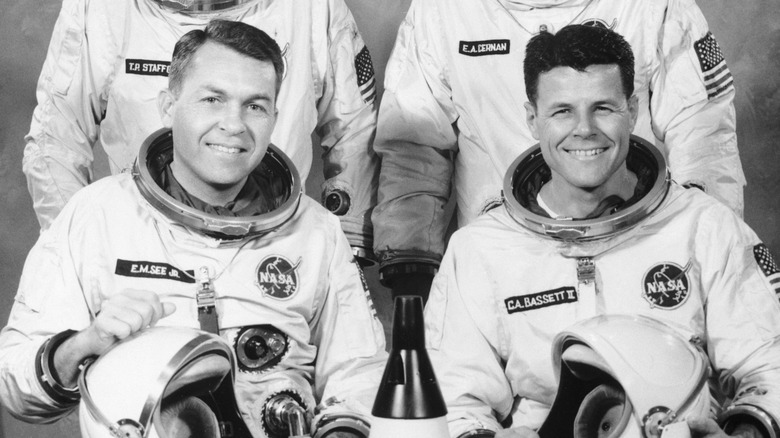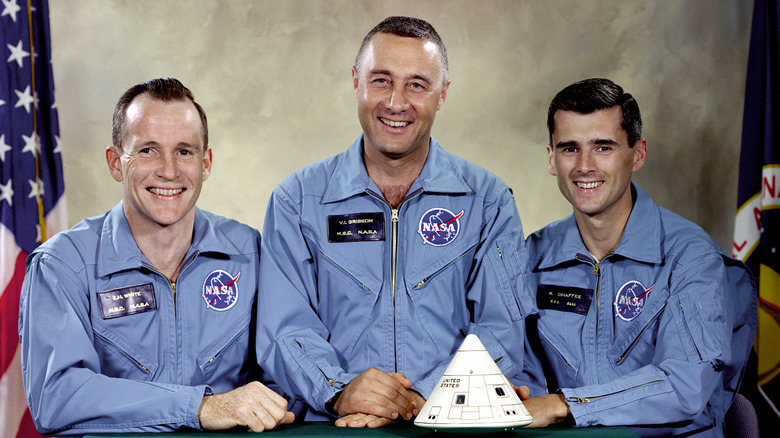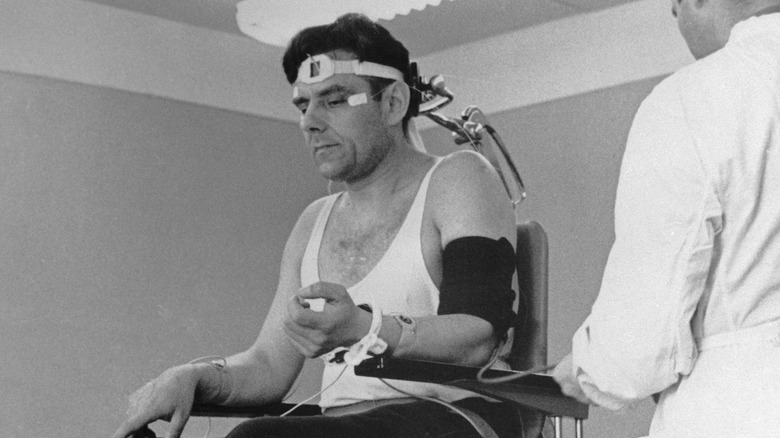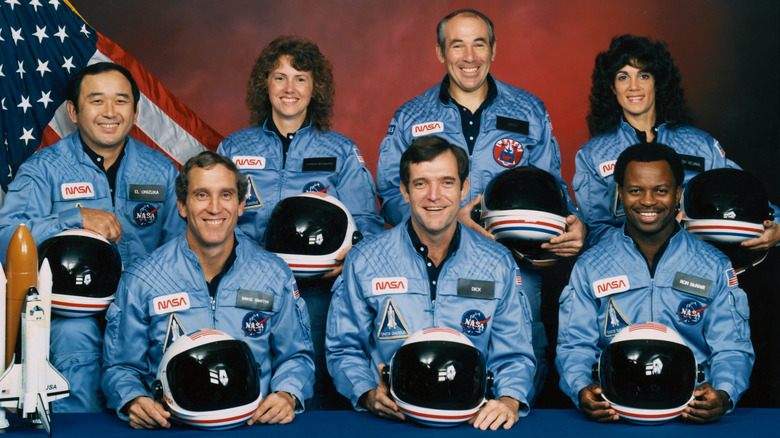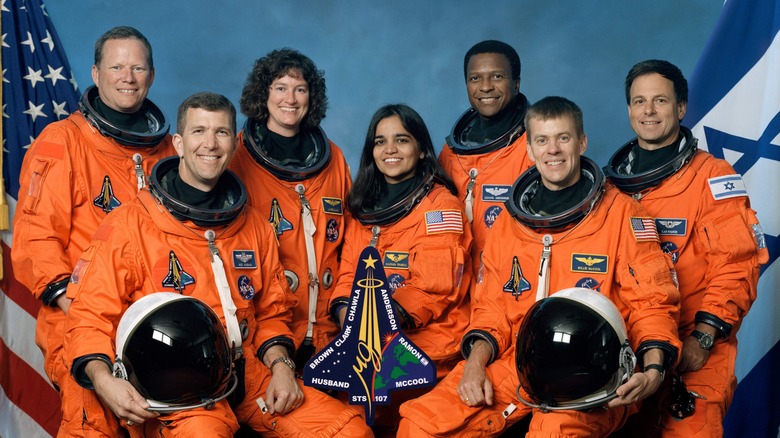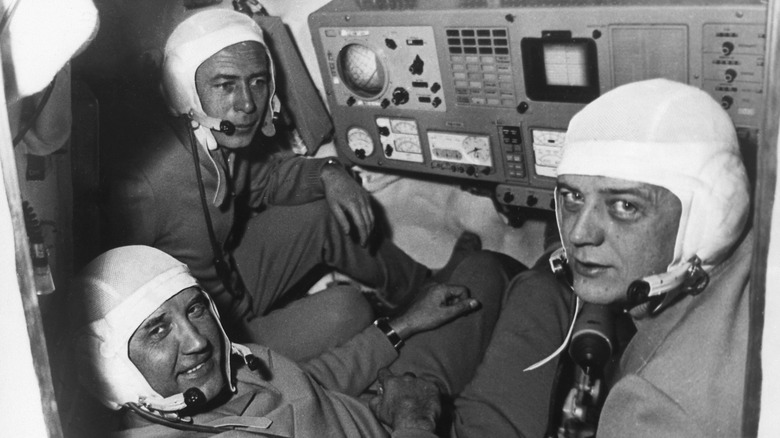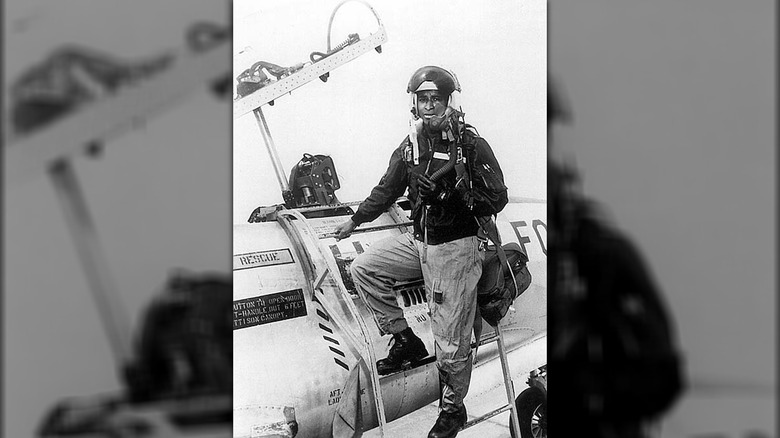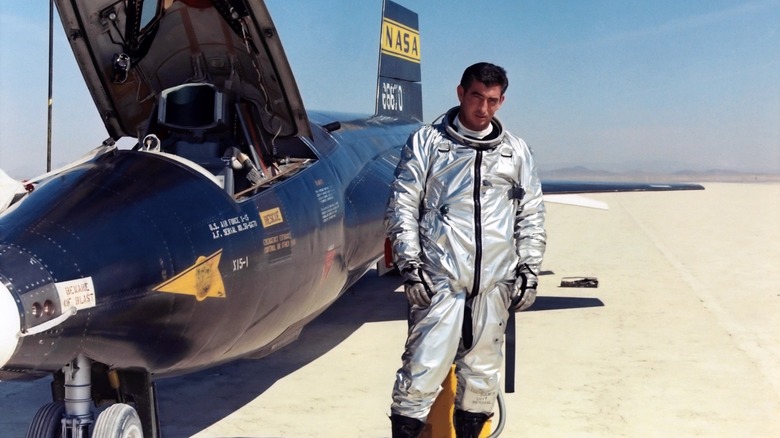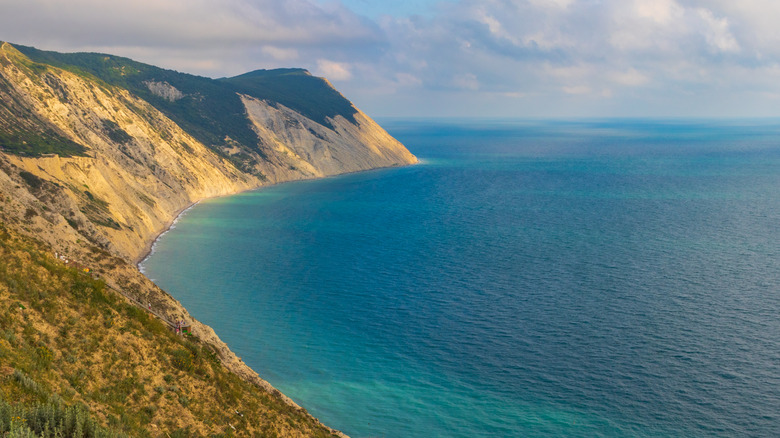Astronauts Who Died Tragically During Missions
Outside Florida's Kennedy Space Center, there stands a giant mirrored wall, over 40 feet high and 50 feet wide. Glowing on this wall, called the Space Mirror Memorial, are 25 names — as of mid-2024 — of astronauts who have died while participating in the U.S. space program. In a sign of how much space travel is changing and moving from the public to the private sector, the most recent entry is a man named Michael Alsbury. In 2014, he was the first commercial astronaut to die during a space mission when Virgin Galactic's VSS Enterprise tore itself apart over California's Mojave Desert.
And while they might go by a different name, on the other side of the world, Russia's cosmonauts put themselves through the same dangers during the hectic risk-taking days of space race and beyond, as their astronaut counterparts did, which meant it was inevitable that they sometimes met a tragic death, too.
Despite the recent interest in space tourism, no one is under any illusions that space travel can be considered especially safe. Yet, today's numerous safeguards and extensive training required for astronauts, whether they be civilian or not, came with a heavy price. From preventable fires to failed parachutes to drowning, the risks of space travel are many, varied, and cruel. Here are the brave souls who gave their lives in humanity's pursuit of the stars.
Valentin Bondarenko
Valentin Bondarenko, like many astronauts, dreamed of flying since childhood. One of the early pioneering cosmonauts against the backdrop of the Cold War and the space race, the Soviet Union quashed his tragic death, and details did not come to light until 1986, the 25th anniversary of Yuri Gagarin's first orbital flight.
At the time of Bondarenko's death in March 1961, 20 cosmonauts — including Gagarin — were taking turns to sit in a soundproofed pressure chamber designed to replicate conditions in space. Aside from simulating the isolation of orbital flight — earning it the nickname the "Chamber of Silence" — the atmospheric pressure was lowered to an equivalent of over three miles of altitude. To provide enough oxygen to breathe, its concentration was increased three-fold to 68%.
Bondarenko sat alone and cocooned in the chamber for 10 days, and when the alert popped up that his time was up, he was more than ready to leave. After pulling the medical sensors away, Bondarenko wiped the adhesive paste off his skin with an alcohol-soaked pad, and, in a fatal moment of carelessness, tossed it away. It landed on a nearby heating coil, ignited, and the flames rapidly engulfed the oxygen-rich chamber, as well as Bondarenko's woolen clothing. Staff rushed to open the chamber, but the depressurization process was still underway, causing the door to remain stubbornly closed. For several agonizing minutes, Bondarenko burned alive, and once staff were able to extract him and rush him to a hospital, held onto life for another eight hours. He eventually died, aged just 24, and some accounts say Gagarin was at his side.
[Featured image by Venzz via Wikimedia Commons | Cropped and scaled | CC BY-SA 4.0]
Elliot See and Charles Bassett
In the early days of the space program, it was not uncommon for astronauts to be recruited from a certain pool of aviators, one with a reputation of being able to fly just about anything: test pilots. And so, it would make sense that these expert pilot astronauts would be trusted to ferry themselves by air to various earthbound mission sites. So it was when Elliot See and Charles Bassett were on their way to St. Louis in a T-38, a supersonic jet piloted by See, to commence flight tests with their Gemini space capsule.
The two astronauts were just a few months away from flying into space, and St. Louis was the home of a large McDonnell complex where the Gemini spacecraft were constructed. However, the weather conditions were poor at the site's landing strip, forcing See to attempt a landing using only his instruments. Despite being an accomplished pilot, fate would not be on See's side. The atrocious visibility caused the jet to miss its landing, strike a nearby building, and crash into an adjacent storage facility. The ground crew in the building suffered some minor injuries but fortunately, none of them died. Even better, the nearby Gemini spacecraft was not damaged.
See and Bassett were not so lucky. The crash flung both men from the plane, which then burst into flames. Both astronauts died instantly.
The Apollo 1 astronauts
After President John F. Kennedy announced in 1961 the USA's intentions to land a man on the moon by the end of the decade, the space race began in earnest. The goal was ambitious, to say the least, but by 1967, the Mercury and Gemini space programs had figured out orbital flight enough to pave the way for NASA's next step: landing on the moon. This stage was the Apollo program, and the three astronauts — Virgil "Gus" Grissom, Ed White, and Roger Chaffee — selected for its first phase were certainly made of the right stuff.
Grissom had in fact been one of the Mercury Seven, the first men selected to be America's astronauts back in 1959. After the Gemini 3 mission in March 1965, two years before his death, he said prophetically (via Time), "If we die, we want people to accept it. We are in a risky business and we hope that if anything happens to us it will not delay the program. The conquest of space is worth the risk of life."
On January 27, 1967, the three astronauts began a ground launch flight test at Cape Canaveral, in the new Apollo 1 command capsule. During the test, an electrical arc ignited the oxygen-rich atmosphere inside the capsule, and technicians frantically spent precious minutes wrestling the hatches open while the astronauts were trapped in the inferno. One small mercy that emerged from the subsequent investigation was that the three men had died from cardiac arrest, and not from their burns, but by carbon monoxide poisoning.
Vladimir Komarov
The year 1967 was full of tragic firsts for the space race. In January of that year, the crew of the Apollo 1 mission died in an inferno, and just two months later, the Soviet Union experienced its own space-related tragedy. As with the Apollo 1 disaster, the cause was a lack of caution and an abundance of risk-taking, and the unlucky victim was cosmonaut Vladimir Komarov.
The Soyuz spacecraft may be familiar to anyone who has even a passing interest in space flight, as it continues to be used as a reliable form of transport to and from orbit, over 50 years since its maiden flight. But that first craft was not the reliable workhorse astronauts know today — far from it. Yuri Gagarin himself was said to have identified over 200 problems with the spaceship and implored his colleagues and superiors to delay the flight, convinced it was a death trap. However, political pressure to proceed with the launch was intense, and so on April 27, 1967, Komarov was strapped into Soyuz 1 and launched into space.
Gagarin's predictions were proven true as soon as Komarov reached orbit. A series of technical hitches plagued the flight, including braking rockets that failed to fire, and Komarov struggled to bring the craft into reentry after over a dozen orbits. As the Soyuz craft plunged to Earth, the final malfunction was with the parachutes, dooming Komarov to a fiery death. The charred remains of the first astronaut to die during a space mission were recovered and buried in the Kremlin, and the Soviet hero even earned a conciliatory message from President Lyndon B. Johnson.
Space Shuttle Challenger disaster
After the space race effectively ended in 1969, with the first moon landing, both the Soviet Union and the U.S. — along with other nations — began to focus on near-Earth orbit. The space shuttle was one of the most iconic products of this period, launching in 1981 and making its last flight in 2011. Designed to ferry teams of astronauts and payloads into orbit, return to Earth, and do it all over again, it promised a future of regular space travel. But this unraveled before everyone's eyes on January 28, 1986, when the space shuttle Challenger exploded 73 seconds after lift-off.
Challenger had already been host to several historic flights, including that of the first female and first Black U.S. astronauts to go to space, Sally Ride and Guion Bluford, respectively. Its 25th flight, designated STS-51-L, was set for another milestone, with the first civilian astronaut, teacher Christa Corrigan McAuliffe, on board, along with six other crew: Francis Scobee, Michael Smith, Ellison Onizuka, Judith Resnik, Ronald McNair, and Gregory Jarvis. Behind the scenes, engineers were concerned about the cold temperatures and the launch was delayed for a short period. Eventually, the all-clear was given.
Less than two minutes into the flight, an O-ring on one of the shuttle's booster rockets failed, later determined to have been partially caused by the freezing temperatures. In an instant, the fuel-laden shuttle was ripped apart by a massive explosion. All the astronauts perished, and it may not have been instantaneous: recovered debris and video footage suggested the crew compartment survived the explosion, and that the seven astronauts died from asphyxiation as they fell to Earth.
Space Shuttle Columbia disaster
By 2003, the space shuttle was a veteran of space flight, and the 113th flight, STS-107, was brimming with experiments designed to probe the effects of microgravity. Space shuttle Columbia lifted off on January 16, 2003, with seven astronauts on board: Rick D. Husband, William C. McCool, Kalpana Chawla, David M. Brown, Laurel B. Clark, Michael P. Anderson, and Ilan Ramon. As an Israeli, Ramon represented the first of his nation to reach space, carrying among his personal belongings a Torah scroll given to him by a Holocaust survivor.
In Columbia's payload bay was a science lab, called the Spacehab Double Research Module, and with this, the crew gathered a huge amount of scientific knowledge during the 16-day mission. After the crew completed an exhausting but fruitful 80 experiments, they prepared the orbiter for reentry. As the shuttle hurtled into the thickening atmosphere at 17,000 miles per hour, the heat-resistant tiles on the underside of the shuttle stood between them and temperatures of up to 3,000 degrees Fahrenheit. Unbeknownst to them, their fate had already been sealed over two weeks earlier, just moments after launch.
Shortly after takeoff, a piece of the shuttle exterior fuel tank's foam insulation had broken free. Caught in the slipstream of the rapidly accelerating spacecraft, it had impacted the leading edge of the shuttle's wing, damaging the heat-resistant tiles. Despite engineers being aware of the damage, no further action was taken, with tragic results. During reentry, superheated plasma penetrated the shuttle and caused it to break up, killing all seven astronauts.
Soyuz 11
Soyuz 11 was meant to be a mission to rejoice. Two months before its launch on June 6, 1971, the Soviet Union had successfully placed humanity's first space station — Salyut 1 — into orbit, and the crew of Soyuz 11 was to be its first residents.
Cosmonauts Georgi Dobrovolski, Vladislav Volkov, and Viktor Patsayev had shot to stardom in the Soviet Union, with the athletic Volkov even becoming a pin-up in his own right. Their mission was not as glamorous as they might have hoped, with conditions in the new space station being so poor that their morale was stretched to breaking point. Nonetheless, the crew persevered, growing cabbage among other tasks, and Patsayev even celebrated his birthday in space — the first person to do so.
The crew of Soyuz 11 were also the first, and so far only, people to die in space proper. Before reentry, the Soyuz capsule needed to jettison the modules no longer necessary for the return trip, leaving only the reentry module and the cosmonauts within. As this took place, a valve was knocked open, and the reentry capsule rapidly depressurized as it began to fall to Earth. While the radio silence from the early stages of the descent was giving the ground crew some concern, optimism still remained as the Soyuz 11 successfully drifted down under its parachutes. Sadly, hope turned to horror once the recovery crew opened the craft, finding all three cosmonauts dead with visible injuries from rapid depressurization and asphyxiation.
Robert Henry Lawrence Jr.
The first Black astronaut, Robert Henry Lawrence Jr., sadly did not live long enough to reach space but was killed training to do so in a tragic accident. Back in the '60s, the U.S. military was heavily involved in the space race, and Air Force pilot extraordinaire Lawrence Jr. was preparing for some serious James-Bond-type space action.
Prior to NASA's civilian space shuttle program, the Air Force had designs to place small space stations in orbit, with a crew of two on a 30-day rotation. These would primarily engage in space-based reconnaissance, spying on the Soviet Union and other adversaries from orbit. Putting a spy in orbit needs a particular set of skills, and Lawrence Jr. was not only a highly accomplished pilot but also held a PhD, gained after spending time as a nuclear research officer for the Air Force. It was this combination of brains and aviation aptitude that saw Lawrence Jr. swiftly poached by the Air Force for its military space station program, called the Manned Orbiting Laboratory. Yet, he was modest about this achievement, stating (via Britannica): "This is nothing dramatic. It's just a normal progression. I've been very fortunate."
On December 8, 1967, Lawrence Jr. was conducting a test flight as an instructor to a trainee. The mission was to train the pilots to glide at steep angles—just as a pilot would need to do when returning from space. As their F-104 Starfighter jet landed, the landing gear collapsed. Both pilots' seats ejected, but Lawrence Jr.'s malfunctioned, killing him. He was 32.
Michael J. Adams
Little did U.S. test pilot Michael Adams' know as he saddled up for another X-15 mission in mid-November 1967 that he would soon become yet another astronaut who perished that tragic year. In doing so, he earned the unfortunate title of the first U.S. astronaut to die during a space mission, albeit on a technicality.
The speeds and altitudes involved in spaceflight posed numerous technical challenges, and the X-15 program yielded valuable information to help solve them. The X-15 was an experimental rocket plane, designed to fly at the extreme edge of the atmosphere, and at hypersonic speeds. Flying the craft under these conditions required superhuman piloting skills, and Adams was the cream of the crop. After gaining an undergraduate degree in Aeronautical Engineering, Adams studied astronautics at MIT before entering the U.S. Air Force Test Pilot School, where he excelled. After the Air Force selected him for its astronaut program, Adams began flying the X-15 in 1966; his seventh flight, on November 15, 1967, was his last.
The initial phases of the fatal flight went well, and, despite a minor electrical fault, Adams was soon soaring at 266,000 feet, earning his astronaut wings in doing so. Sadly, the wings would be awarded posthumously: after Adams had executed a risky wing-rocking maneuver, the plane entered a spin. The X-15 hurtled down at a stomach-churning Mach 5, and despite Adams' best efforts — which almost succeeded, despite the crushing 15g forces — his plane broke up midair, killing him.
Sergey Vozovikov
You might assume that the only really dangerous part of going into space is the part where you are actually in space. But in reality, every bit of space flight is a risky business, and so training to be an astronaut needs to cover just about every eventuality from beginning to end. Even after the mission is over, on their return, potential spacefarers face the risks of landing in water, and so need to be just as proficient floating in that environment as they do in space. This training, of course, carries its own risks, as the tragic story of Sergey Vozovikov demonstrates.
In July 1993, just a handful of years after the collapse of the Soviet Union, and while Russia lurched from crisis to crisis, the space program in that country continued apace. A newly selected cosmonaut, Vozovikov was preparing for a mission to the Russian space station Mir, now long since fallen to earth. As part of his training, he was taking part in a water survival training program in the Black Sea, not far from Crimea. Tragically, Vozovikov became caught in a drifting fishing net and drowned. He was 35.
